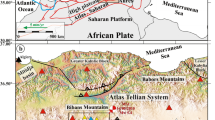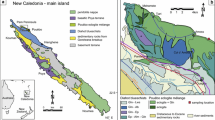Abstract
Fluid flow patterns have been determined using oxygen isotope isopleths in the Val-d’Or orogenic gold district. 3D numerical modelling of fluid flow and oxygen isotope exchange in the vein field shows that the fluid flow patterns can be reproduced if the lower boundary of the model is permeable, which represents middle or lower crustal rocks that are infiltrated by a metamorphic fluid generated at deeper levels. This boundary condition implies that the major crustal faults so conspicuous in vein fields do not act as the only major channel for upward fluid flow. The upper model boundary is impermeable except along the trace of major crustal faults where fluids are allowed to drain out of the vein field. This upper impermeable boundary condition represents a low-permeability layer in the crust that separates the overpressured fluid from the overlying hydrostatic fluid pressure regime. We propose that the role of major crustal faults in overpressured vein fields, independent of tectonic setting, is to drain hydrothermal fluids out of the vein field along a breach across an impermeable layer higher in the crust and above the vein field. This breach is crucial to allow flow out of the vein field and accumulation of metals in the fractures, and this breach has major implications for exploration for mineral resources. We propose that tectonic events that cause episodic metamorphic dehydration create a short-lived pulse of metamorphic fluid to rise along zones of transient permeability. This results in a fluid wave that propagates upward carrying metals to the mineralized area. Earthquakes along crustal shear zones cause dilation near jogs that draw fluids and deposit metals in an interconnected network of subsidiary shear zones. Fluid flow is arrested by an impermeable barrier separating the hydrostatic and lithostatic fluid pressure regimes. Fluids flow through the evolving and interconnected network of shear zones and by advection through the rock matrix. Episodic breaches in the impermeable barrier along the crustal shear zones allow fluid flow out of the vein field.













Similar content being viewed by others
References
Badertscher NP, Beaudoin G, Therrien R, Burkhard M (2002) Glarus overthrust: a major pathway for the escape of fluids out of the Alpine orogen. Geology 30:875–878
Beaudoin G, Therrien R (1999) Sources and drains: major controls of hydrothermal fluid flow in the Kokanee Range, British Columbia, Canada. Geology 27:883–886
Beaudoin G, Gagnon Y (2001) Oxygen isotope cross-section of the synvolcanic VMS hydrothermal system of the Val-d’Or camp. In: GAC-MAC annual meeting, program with abstract, p 9
Beaudoin G, Pitre D (2005) Stable isotope geochemistry of the Archean Val-d’Or (Canada) orogenic gold vein field. Miner Depos 40:59–75
Beaudoin G, Roddick JC, Sangster DF (1992a) Eocene age for Ag–Pb–Zn–Au vein and replacement deposits of the Kokanee range, Southeastern British Columbia. Can J Earth Sci 29:3–14
Beaudoin G, Taylor BE, Sangster DF (1992b) Silver–lead–zinc veins and crustal hydrology during Eocene extension, southeastern British Columbia, Canada. Geochim Cosmochim Acta 56:3513–3529
Boullier A-M, Robert F (1992) Paleoseismic events recorded in Archaean gold–quartz vein networks, Val d’Or, Abitibi, Quebec, Canada. J Struct Geol 14:161–179
Bowman JR, Willett SD, Cook SJ (1994) Oxygen isotopic transport and exchange during fluid flow: one-dimensional models and applications. Am J Sci 294:1–55
Carr SD, Parrish RR, Brown RL (1987) Eocene structural development of the Valhalla Complex, southeastern British Columbia. Tectonics 6:175–196
Cole DR, Chakraborty S (2001) Rates and mechanisms of isotopic exchange. In: Valley JW, Cole DR (eds) Stable isotope geochemistry. The Mineralogical Society of America, Washington, pp 83–224
Cole DR, Ohmoto H, Jacobs GK (1992) Isotopic exchange in mineral–fluid systems: III. Rates and mechanisms of oxygen isotope exchange in the system granite–H2O±NaCl±KCl at hydrothermal conditions. Geochim Cosmochim Acta 56:445–466
Connolly JAD (1997) Devolatilization-generated fluid pressure and deformation-propagated fluid flow during prograde regional metamorphism. J Geophys Res 102:18149–18173
Couture J-F, Pilote P, Machado N, Desrochers J-P (1994) Timing of gold mineralization in the Val-d’Or district, southern Abitibi Belt: evidence for two distinct mineralizing events. Econ Geol 89:1542–1551
Cox SF (2005) Coupling between deformation, fluid pressures, and fluid flow in ore-producing hydrothermal systems at depth in the crust. In: Hedenquist JW, Thompson JFH, Goldfarb RJ, Richards JP (eds) One hundredth anniversary volume. Society of Economic Geologists, Littleton, CO, pp 39–75
Cox SF, Ruming K (2004) The St Ives mesothermal gold system, Western Australia—a case of golden aftershocks? J Struct Geol 26:1109–1125
Cox SF, Knackstedt MA, Braun J (2001) Principles of structural control on permeability and fluid flow in hydrothermal systems. In: Richards JP, Tosdal RM (eds) Structural controls on ore genesis, structural controls on ore genesis. Reviews in economic geology, vol 14. Society of Economic Geologists, Littleton, CO, pp 1–24
Criss RE, Gregory RT, Taylor HP (1987) Kinetic theory of oxygen isotopic exchange between minerals and water. Geochim Cosmochim Acta 51:1099–1108
Daigneault R (1996) Couloirs de déformation de la Sous-Province de l’Abitibi. Ministère des Ressources naturelles du Québec, Québec, p 115
Daigneault R, Mueller WU, Chown EH (2002) Oblique Archean subduction: accretion and exhumation of an oceanic arc during dextral transpression, Southern Volcanic Zone, Abitibi Subprovince Canada. Precambrian Res 115:261–290
Desrochers JP, Hubert C (1996) Structural evolution and early accretion of the Archean Malartic composite block, southern Abitibi greenstone belt, Quebec, Canada. Can J Earth Sci 33:1556–1569
Domenico PA, Schwartz FW (1998) Physical and chemical hydrogeology. Wiley, New York
Eisenlohr BN, Groves DI, Partington GA (1989) Crustal-scale shear zones and their significance to Archean gold mineralization in Western Australia. Miner Depos 24:1–8
Galley AG (1993) Characteristics of semi-conformable alteration zones associated with volcanogenic massive sulphide districts. J Geochem Explor 48:175–200
Garofalo PS (2000) Gold precipitation and hydrothermal alteration during fluid flow through the vein network of the mesothermal gold deposit of Sigma (Abitibi belt, Canada). Swiss Federal Institute of Technology Zurich, Zurich, p 252
Goldfarb RJ, Snee LW, Miller LD, Newberry RJ (1991) Rapid dewatering of the crust deduced from ages of mesothermal gold deposits. Nature 354:296–298
Goldfarb RJ, Groves DI, Gardoll S (2001) Orogenic gold and geologic time: a global synthesis. Ore Geol Rev 18:1–75
Green AG, Milkreit B, Mayrand LJ, Ludden JN, Hubert C, Jackson SL, Sutcliffe RH, West GF, Verpaelst P, Simard A (1990) Deep structure of an Archean greenstone terrane. Nature 344:327–330
Groves DI (1993) The crustal continuum model for the late-Archaean lode-gold deposits of the Yilgarn Block, Western Australia. Miner Depos 28:366–374
Groves DI, Goldfarb RJ, Gebre-Mariam M, Hagemann SG, Robert F (1998) Orogenic gold deposits: a proposed classification in the context of their crustal distribution and relationship to other gold deposit types. Ore Geol Rev 13:7–27
Groves DI, Goldfarb RJ, Robert F, Hart CJR (2003) Gold deposits in metamorphic belts: overview of current understanding, outstanding problems, future research, and exploration significance. Econ Geol 98:1–29
Hagemann SG, Cassidy KF (2000) Archean orogenic lode gold deposits. In: Hagemann SG, Brown PE (eds) Gold in 2000. The Society of Economic Geologists, Littleton, CO, pp 9–68
Hanes JA, Archibald DA, Hodgson CJ, Robert F (1992) Dating of Archeran auriferous quartz vein deposits in the Abitibi Greenstone Belt, Canada: 40Ar/39Ar evidence for a 70- to 100-m.y.-time gap between plutonism–metamorphism and mineralization. Econ Geol 87:1849–1861
Hubert C, Trudel P, Gelinas L (1984) Archean wrench fault tectonics and structural evolution of the Blake River Group, Abitibi Belt, Quebec. Can J Earth Sci 21:1024–1032
Ingebritsen SE, Sanford WE (1998) Groundwater in geologic processes. Cambridge University Press, Cambridge
Irwin PW, Barnes I (1980) Tectonic relations of carbon dioxide discharges and earthquakes. J Geophys Res 85:3115–3121
Jamieson RA, Beaumont C, Fullsack P, Lee B (eds) (1998) Barrovian regional metamorphism: where’s the heat? Geological Society, London
Jébrak M, LeQuentrec MF, Mareschal J-C, Blais D (1991) A gravity survey across the Bourlamaque massif, southeastern Abitibi greenstone belt, Québec, Canada: the relationship between the geometry of the tonalite plutons and associated gold mineralization. Precambrian Res 50:261–268
Kerrich R, Ludden J (2000) The role of fluids during formation and evolution of the southern Superior Province lithosphere: an overview. Can J Earth Sci 37:135–164
Kerrich R, Wyman DA (1990) Geodynamic setting of mesothermal gold deposits. An association with accretionary tectonic regimes. Geology 18:882–885
Kerrich R, Fryer BJ, King RW, Willmore LM, van Hees E (1987) Crustal outgassing and LILE enrichment in major lithosphere structures, Archean Abitibi greenstone belt: evidence on the source reservoir from strontium and carbon isotope tracers. Contrib Mineral Petrol 97:156–168
Manning CE, Ingebritsen SE (1999) Permeability of the continental crust: Implications of geothermal data and metamorphic systems. Rev Geophys 37:127–150
Micklethwaite S, Cox SF (2004) Fault-segment rupture, aftershock-zone fluid flow, and mineralization. Geology 32:813–816
Miller LD, Goldfarb RJ, Gehrels GE, Snee LW (1994) Genetic links among fluid cycling, vein formation, regional deformation, and plutonism in the Juneau gold belt, southeastern Alaska. Geology 22:203–206
Muir-Wood R (1994) Earthquakes, strain-cycling and the mobilization of fluids. In: Parnell J (ed) Geofluids: origin, migration and evolution of fluids in sedimentary basins. Geological Society, London, pp 85–98
Neumayr P, Hagemann SG (2002) Hydrothermal fluid evolution within the Cadillac tectonic zone, Abitibi greenstone belt, Canada: relationship to auriferous fluids in adjacent second- and third-order shear zones. Econ Geol 97:1203–1225
Neumayr P, Hagemann SG, Couture J-F (2000) Structural setting, textures, and timing of hydrothermal vein systems in the Val d’Or camp, Abitibi, Canada: implications for the evolution of transcrustal, second- and third-order fault zones and gold mineralization. Can J Earth Sci 37:95–114
Perchuk A, Philippot P, Erdmer P, Fialin M (1999) Rates of thermal equilibration at the onset of subduction deduced from diffusion modeling of eclogitic garnets, Yukon-Tanana terrane, Canada. Geology 27:531–534
Pitre D (2000) Zonation isotopique à l’échelle d’un champ filonien aurifère: le camp mininer de Val-d’Or, Abitibi, Québec Géologie et génie géologique. Université Laval, Québec, p 154
Robert F (1989) Internal structure of the Cadillac tectonic zone southeast of Val d’Or, Abitibi greenstone belt, Quebec. Can J Earth Sci 26:2661–2675
Robert F (1994) Vein fields in gold districts: the example of Val-d’Or, southeastern Abitibi province. Current research part C. Geological Survey of Canada, Ottawa, pp 295–302
Robert F, Brown AC (1986) Archean gold-bearing quartz veins at the Sigma mine, Abitibi greenstone belt, Quebec: part I. Geologic relations and formation of the vein system. Econ Geol 81:578–592
Robert F, Kelly WC (1987) Ore-forming fluids in Archean gold-bearing quartz veins at the Sigma Mine, Abitibi Greenstone belt, Quebec, Canada. Econ Geol 82:1464–1482
Robert F, Boullier A-M, Firdaous K (1995) Gold–quartz veins in metamorphic terranes and their bearing on the role of fluids in faulting. J Geophys Res 100:12861–12879
Roy P, Beaudoin G, Labbé J-Y (1997) Les minéralisations aurifères associées au couloir de déformation de Cameron. Ministère de Ressources Naturelles du Québec, Québec, p 27
Sibson RH, Scott J (1998) Sress/fault controls on the containment and release of overpressured fluids: examples from gold–quartz vein systems in Juneau, Alaska; Victoria, Australia and Otago, New Zealand. Ore Geol Rev 13:293–306
Sibson RH, Robert F, Poulsen KH (1988) High-angle reverse faults, fluid-pressure cycling, and mesothermal gold–quartz deposits. Geology 16:551–555
Tenthorey E, Cox SF (2003) Reaction-enhanced permeability during serpentinite dehydration. Geology 31:921–924
Therrien R, Sudicky EA (1996) Three-dimensional analysis of variably-saturated flow and solute transport in discretely-fractured porous media. J Contam Hydrol 23:1–44
Weinberg RF, Hodkiewicz PF, Groves DI (2004) What controls gold distribution in Archean terranes? Geology 32:545–548
Zoback MD, Townend J (2001) Implications of hydrostatic pore pressures and high crustal strength for the deformation of intraplate lithosphere. Tectonophysics 336:19–30
Acknowledgements
This research has been supported by a research grant from the Fonds québécois de la recherche sur la nature et les technologies to the research team MEDEF and by Natural Sciences and Engineering Research Council of Canada Discovery grants to GB and RT. Their long-term support is gratefully acknowledged. Detailed and constructive reviews by S.F. Cox, R.J. Goldfarb and R. Weinberg helped improve significantly this paper.
Author information
Authors and Affiliations
Corresponding author
Additional information
Editorial handling: R. Goldfarb
Rights and permissions
About this article
Cite this article
Beaudoin, G., Therrien, R. & Savard, C. 3D numerical modelling of fluid flow in the Val-d’Or orogenic gold district: major crustal shear zones drain fluids from overpressured vein fields. Miner Deposita 41, 82–98 (2006). https://doi.org/10.1007/s00126-005-0043-5
Received:
Accepted:
Published:
Issue Date:
DOI: https://doi.org/10.1007/s00126-005-0043-5




